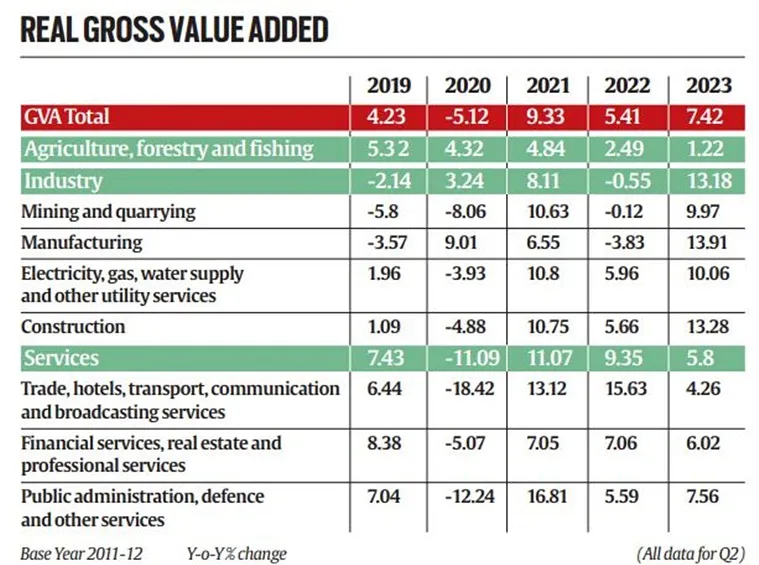Indian Economy
GDP Growth Surprise
- 05 Dec 2023
- 6 min read
For Prelims: Gross Domestic Product (GDP), Production-linked incentive scheme, National infrastructure pipeline , Ministry of Statistics and Programme Implementation (MoSPI).
For Mains: India’s GDP Growth, Calculations Methods For GDP in India, Positive Factors that Can Help India Recover from the Slump.
Why in News?
According to the latest data from the Ministry of Statistics and Programme Implementation (MoSPI) , India’s Gross Domestic Product (GDP) grew by 7.6% in second quarter (Q2) of 2023-24, covering the months of July to September.
- India’s economy in Q2 witnessed a decline in agriculture, a surge in manufacturing, and a slowdown in services sectors.
What is the Significance of This Growth Data?
- Not only is this a fairly impressive level of economic growth, it also beats all market expectations.
- The recent quarterly GDP growth has triggered a flurry of upward revisions in the GDP forecast for the full financial year.
- It appears that India's central bank accurately predicted the country's GDP growth rate for the fiscal year, despite initially seeming optimistic compared to other economists.
- Now, with many experts revising their projections to align with the bank's forecast of 6.5%, the Reserve Bank of India (RBI) seems to have made an accurate prediction.
- This also means that RBI is unlikely to cut interest rates sooner than expected. Had the growth rate been below market expectations, the probability of a rate cut would have heightened.
- It is also noteworthy that it was exactly three years ago — when MoSPI announced the Q2 GDP data for 2020-21 — that India went into a technical recession. The upside surprise on growth has given hope that India’s economic recovery is now gathering momentum.
What are the Different Ways of Measuring Economic Growth?
- Two Ways to Calculate Economic Growth:
- GDP:
- It involves examining people's spending patterns (the expenditure side). GDP can be derived from Gross Value Added (GVA) by incorporating indirect taxes and subtracting government subsidies.
- GVA:
- It focuses on the income side of the economy. GVA, as defined by the RBI, is the value of a sector's output minus the value of its intermediary inputs. This "value added" is distributed among the primary factors of production—labor and capital.
- GDP:
- Disparity Between the Two Methods:
- The disparity between the two methods is termed a discrepancy and has sparked controversies, notably during the release of first-quarter GDP data.
- For a nuanced analysis of quarterly economic trends, GVA numbers are often considered more reliable, while GDP (expenditure data) is preferred for assessing annual trends.
What Needs to be Done to Make India's Growth Rate More Robust?
- Boosting Investment and Consumption: These are the two main drivers of domestic demand, which accounts for about 70% of India’s GDP.
- To increase investment, the government can continue to implement reforms that reduce policy uncertainty, regulatory hurdles, interest rates, and bad loans.
- To increase consumption, the government can support income growth, inflation control, rural development, job creation, and credit availability.
- Enhancing Manufacturing and Exports: These are the key sources of value addition, employment, and external demand, which can help India diversify its economy and integrate with the global market.
- To improve manufacturing and exports, the government can continue to implement initiatives such as the Atmanirbhar Bharat package, the production-linked incentive scheme, and the national infrastructure pipeline.
- Investing in Human Capital and Social Services: These are the essential factors for improving the living standards and productivity of India’s large and young population.
- To invest in human capital and social services, the government can continue to implement programs that enhance education, health, skills, nutrition, water, sanitation, energy, housing, and healthcare.
- Maintaining Macroeconomic Stability and Resilience: These are the necessary conditions for sustaining economic growth and coping with various shocks and uncertainties.
- To maintain macroeconomic stability and resilience, the government can continue to pursue prudent fiscal and monetary policies that balance growth and inflation objectives.
UPSC Civil Services Examination, Previous Year Questions (PYQs)
Prelims:
Q. Increase in absolute and per capita real GNP do not connote a higher level of economic development, if: (2018)
(a) Industrial output fails to keep pace with agricultural output.
(b) Agricultural output fails to keep pace with industrial output.
(c) Poverty and unemployment increase.
(d) Imports grow faster than exports.
Ans:(c)
Q. In a given year in India, official poverty lines are higher in some States than in others because: (2019)
(a) Poverty rates vary from State to State
(b) Price levels vary from State to State
(c) Gross State Product varies from State to State
(d) Quality of public distribution varies from State to State
Ans: (b)







